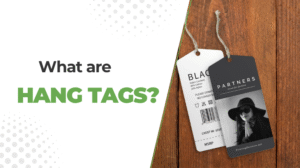Many businesses struggle to decide whether ahang tagor alabelcommunicates their brand more effectively. The confusion often starts when designing packaging that must look professional yet meet retail and compliance standards. A hang tag adds visual appeal and branding power, while a label carries vital product data like care instructions, material composition, and safety details. Choosing the wrong one can affect how customers perceive your brand’s quality and trust.
In this blog you will get to know the practical differences between hang tags and product labels, their specific roles in branding, manufacturing, and retail presentation, and how to select the right option for your products.
Key Takeaways
- Hang tags are small labels on products that do more than show price—they tell your brand story, communicate quality, and help your items stand out in busy retail spaces.
- Effective hang tags include essential product details like brand name, logo, description, size, price, material, care instructions, and sustainability or ethical sourcing information to build customer trust.
- Adding interactive and personalized elements—such as QR codes, social links, taglines, or thank-you notes—enhances engagement, encourages repeat interaction, and strengthens brand loyalty.
What Is the Main Difference Between Hang Tags and Labels?
Hang tags are removable paper-based tags attached to products using a string or loop. They display marketing details, pricing, brand stories, or promotional messages that attract customers before purchase.
Labels are permanent identifiers that stay fixed to the product, either stitched, woven, or adhered directly to its surface. They contain essential information such as size, care instructions, fabric content, ingredients, and country of origin—often required by retail and manufacturing regulations.
What Are Labels?
Labels are identifiers attached directly to a product or its packaging. They convey essential product information and reinforce brand identity. Labels serve as the primary source of instructions, care details, and compliance information for consumers.
Benefits of Labels
- Brand Recognition:Display logos, colors, and messaging directly on the product, making the brand immediately recognizable.
- Information Delivery:Provide instructions, ingredients, care guidance, and regulatory compliance details.
- Consumer Trust:Clear and accurate labels increase confidence in product quality and safety.
- Inventory and Tracking:Labels often integrate barcodes or QR codes to streamline logistics and supply chain processes.
- Cost Efficiency:Labels are a cost-effective way to communicate essential details without additional marketing materials.
Uses of Labels
- Communicate size, material, and care instructions in apparel.
- Display nutrition, ingredients, and expiry dates on food and beverage products.
- Provide warranty information, serial numbers, and safety warnings for electronics and industrial goods.
- Convey legal or safety compliance information on regulated products.
What Are Hang Tags?
Hang tags are separate pieces attached to a product, usually via string, ribbon, or fastener. They emphasize branding, storytelling, and consumer engagement rather than regulatory or compliance needs. Hang tags are often a brand’s first tactile interaction with the consumer.
5. Sustainability and Ethical Sourcing
Today’s shoppers value transparency and sustainability. Use your tag to highlight eco-conscious practices like recycled paper stock, biodegradable ink, or ethical sourcing. Add short phrases such as:
- “Printed on 100% recycled paper”
- “Made with responsibly sourced materials”
- “Carbon neutral printing”
6. Social Media and Website Links
Hang tags connect the offline experience to your online presence. Add social handles, your website, or a QR code that links directly to your shop or brand story. Use simple prompts like “Scan to learn more” or “Follow us for new arrivals.” It keeps customers engaged beyond the point of purchase and encourages brand interaction.
7. Tagline or Brand Message
A short tagline reinforces emotion and identity. It could express your design philosophy or product purpose — phrases like “Crafted for everyday joy” or “Designed for modern living” make the brand memorable. Keep it authentic, simple, and aligned with your tone.
8. Personalized Notes or Promotions
A small message can create a strong connection. Add a thank-you line or personalized note for a warm, human touch. You can also include QR codes that unlock offers, discount codes, or loyalty rewards.
Conclusion
Hang tags go beyond basic labeling — they express your brand’s story, quality, and values in a small but powerful format. When designed with intention, they elevate product appeal and create emotional connections with shoppers.
By combining clear product details with thoughtful design, sustainability cues, and interactive touches, your tags can turn a simple purchase into a memorable experience. In a crowded retail space, well-crafted hang tags don’t just inform — they inspire recognition, trust, and long-term brand loyalty.




